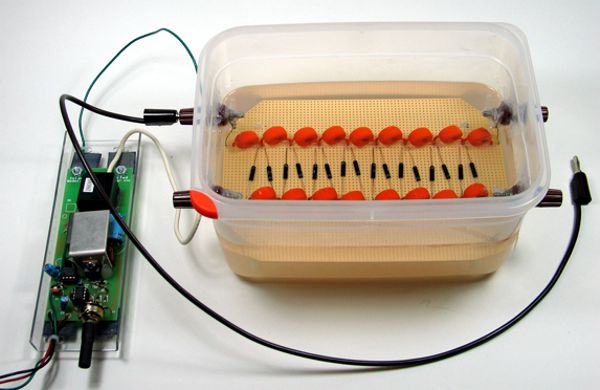
High voltage DC power supplies are used by science enthusiasts for powering electron tubes and x-ray tubes, charging high-voltage capacitors, powering electrostatic “levitators”, etc. Many of these power supplies use a flyback transformer to produce high voltage at high frequency (AC), followed by a “Cockroft-Walton Multiplier” to rectify and dramatically increase the voltage.
The Cockroft-Walton multiplier uses a cascaded series of diodes and capacitors to generate a high voltage DC potential from an AC input through a circuit topology that uses diodes to charge capacitors in parallel and discharge them in series. The output polarity of the Cockroft-Walton multiplier depends on the way in which its diodes are oriented, so the output polarity (referenced to ground) of a high-voltage DC power supply is usually set during the design.
However, since some of our physics experiments require one or the other polarity, we build our Cockroft-Walton multipliers with an extra capacitor so that we can make our HV power supplies output either positive or negative high voltage referenced to ground. The schematic for our “reversible” Cockroft-Walton is shown in the following picture (click to enlarge): 
If the high-voltage AC output of the flyback is connected to point “A” of the voltage multiplier, and point “B” is connected to ground, then the output at point “D” will be positive. If however point “C” receives the high-voltage AC, and point “D” is connected to ground, then point “B” will be negative.
As shown in the following pictures, the multiplier should be built on a piece of clean perfboard:


The circuit board is then suspended by nylon spacers inside a plastic enclosure (of the type used to store food):

Banana connectors are then installed on the plastic container and wired directly to points A, B, C, and D. The connectors must be sealed very well using silicone RTV:

The connectors are then labeled as follows:


The plastic container should then be filled with pure mineral oil (may be purchased at a pharmacy) to completely submerge the multiplier circuit assembly, which prevents high voltage breakdown between components:

You can use any high-voltage AC power supply to drive the multiplier. Our favorite circuit is the following DC-to-AC inverter (click diagram to enlarge):
In this AC power supply, a push-pull oscillator drives a TV flyback transformer from an old color TV (a flyback without embedded tripler). The well-known hack is that the original primary of the flyback is not used. Instead, new primaries are made by winding two sets of four turns each of insulated #18 wire around the exposed core of the flyback transformer. Feedback for the oscillator is obtained through an additional coil of 4 turns of #24 wire wound around the core:


As shown in the picture above, we built the low-voltage DC power supply right into the chassis. We vary the voltage using an external variac (not shown in the pictures). In our power supply, 12 V applied at the input of the flyback driver produces around 250 kV DC at the output of the multiplier. We have measured up to 300 kV DC at higher input voltages, but the corona and breakdown get very scary, so we haven’t tried pushing the limit.
UPDATE 2/10/2012: Please see the following two posts for additional information on building the resonant transformer driver, as well as on winding the primary for the flyback transformer:
The following YouTube video shows an early version of our d.i.y. power supply being used to fly an electrostatic “lifter” that Shanni built many years ago as a grade-school science-fair project:
In our d.i.y. book “Exploring Quantum Physics Through Hands-On Projects” we show many ways in which this power supply can be used to perform advanced physics experiments.
DANGER! Please note that this is a dangerous device! It produces high voltages which can cause very painful or lethal electrical shocks. In addition, spark discharges can be produced which can ignite flammable materials or volatile atmospheres. Remember that the capacitors retain charge long after the power supply is switched off. Thoroughly discharge them before touching the high voltage rails!

